Using A Deck Sling
By Wayne Horodowich
Many years ago I saw a very simple piece of equipment that
I filed away in my memory bank and forgot to retrieve it. In April 2006 I
sat in on a wonderful presentation on towing given by Les & Diane Uhrich.
During the demonstration Les had this piece of equipment on his front deck.
If I recall correctly Les called it a "Paddle Park." I originally
heard it referred to as a "Deck Sling" so I am going to use that
as the name for this useful tool. In addition I have heard the term paddle
park used to describe certain paddle leashes.
I have since played with this device over the past few months.
I have to say I am liking it more and more. I enjoy using tools that are multifunctional.
The deck sling is easily made to meet your needs. It is simply a length of
webbing or rope with a clip on each end.
The deck sling stays attached to the deck rigging on your
front deck until you need the use of a short tether. One of the beautiful
aspects of the deck sling is its ability to change its length.
Let's look at the deck sling and some of its possible uses.
This simple piece of equipment can be very useful in a variety of skills.
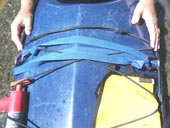 In the first picture you can see the deck sling when it is
secured on the front deck. One of the many things I like about the sling is
it's low profile. I am using a flat webbing that used to be a tie down strap
with a buckle. When the buckle corroded I cut off the strap for other uses.
I tried it for the sling and it seems to be working well. I used two carabiners
that I had hanging around in my garage for testing purposes. When I get a
chance, I will use two stainless steel clips that don't have notches, which
can hook on lines when disconnecting. The clips are also smaller than the
carabiners seen here. See USK article, "Clipping
In For A Tow" for more details about the clips.
In the first picture you can see the deck sling when it is
secured on the front deck. One of the many things I like about the sling is
it's low profile. I am using a flat webbing that used to be a tie down strap
with a buckle. When the buckle corroded I cut off the strap for other uses.
I tried it for the sling and it seems to be working well. I used two carabiners
that I had hanging around in my garage for testing purposes. When I get a
chance, I will use two stainless steel clips that don't have notches, which
can hook on lines when disconnecting. The clips are also smaller than the
carabiners seen here. See USK article, "Clipping
In For A Tow" for more details about the clips.
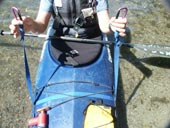 When the sling has both ends disconnected you can see how
it is placed under the deck rigging. It is important to have it sliding under
all deck lines. The outer most lines need to be static deck lines. If you
only have elastic deck lines then you lose certain functions that can only
be achieved with static (non-elastic) side deck lines.
When the sling has both ends disconnected you can see how
it is placed under the deck rigging. It is important to have it sliding under
all deck lines. The outer most lines need to be static deck lines. If you
only have elastic deck lines then you lose certain functions that can only
be achieved with static (non-elastic) side deck lines.
If you have it connected correctly, the deck sling can slide
from side to side under your deck rigging. When I pull up on the right side
the left side gets shorter as seen in the very last photo in this article. As we will discuss,
this provides wonderful options. When the sling is closed on your deck there
is some play in the sling. It needs to be loose enough to connect and disconnect
to your deck rigging easily.
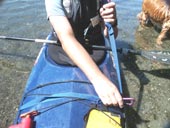 To close the sling down to the deck, clip one side to the
outside deck line by crossing over the deck. This leaves you with one free
end. That free end is a convenient tether when you need it. Depending on which
side you need the tether, unclip the end you need.
To close the sling down to the deck, clip one side to the
outside deck line by crossing over the deck. This leaves you with one free
end. That free end is a convenient tether when you need it. Depending on which
side you need the tether, unclip the end you need.
After you have clipped the first end to one side deck line,
you can clip the remaining end to the opposite side deck line. When one end
it attached and one end is free the free end is a static tether. The webbing
I am using covers up more deck space as compared to a strong piece of cord.
This is a concern if I have a chart case under it. I would want more visibility
of my chart so the webbing may get in the way.
Thus far I have not found the sling interfering with any of
my techniques when it is in the closed position. The tension on the sling,
in its closed position, is loose enough to easily connect and disconnect from
my deck rigging, but not so loose that it becomes a safety issue with respect
to entanglement.
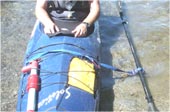 As for uses of this versatile tether, just think of all the
times you wish you had a quick way to attach something you didn't want to
drift or blow away. As you can see in one of the pictures, I have attached
the sling to hold my paddle. Since the clip is too small to clip over the
paddle shaft, I just wrapped the sling around the shaft and clipped the sling
to itself. Now I have hands free operation and my paddle stays close by.
As for uses of this versatile tether, just think of all the
times you wish you had a quick way to attach something you didn't want to
drift or blow away. As you can see in one of the pictures, I have attached
the sling to hold my paddle. Since the clip is too small to clip over the
paddle shaft, I just wrapped the sling around the shaft and clipped the sling
to itself. Now I have hands free operation and my paddle stays close by.
This short tether is also good for short distance towing.
There are times when you need to pull a kayak quickly out of harms way. Short
static tethers are the way to go. You can also clip onto your partners kayak
if they are next to you and the two of you don't want to drift apart but you
need to use your hands for something else.
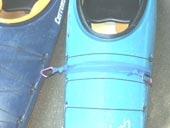 In the USK article, "One
Towing Two", I mention the use of the sling to help hold the kayaks
together when you need to stabilize a kayak during a tow. Since there is some
slack in the system I can clip one end to my partner's deck line but keep
them on a very short tether
In the USK article, "One
Towing Two", I mention the use of the sling to help hold the kayaks
together when you need to stabilize a kayak during a tow. Since there is some
slack in the system I can clip one end to my partner's deck line but keep
them on a very short tether
If you were in the water and you had to help someone else
and you wanted to keep you kayak nearby the deck sling could be your answer. You can tether the kayak to your PFD.
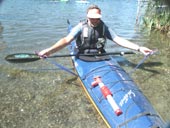 As I mentioned earlier, the deck sling can slide from side
to side. This flexibility in length can be useful when towing a kayak where
the bow gets too close to your kidneys. When both ends are unclipped the sling
has equal length of tether on each side. However, when I pull on one side
to get more tether the other side gets shorter.
As I mentioned earlier, the deck sling can slide from side
to side. This flexibility in length can be useful when towing a kayak where
the bow gets too close to your kidneys. When both ends are unclipped the sling
has equal length of tether on each side. However, when I pull on one side
to get more tether the other side gets shorter.
In its simplest use I have three lengths of tether. If you
want it long, undo both ends and pull as much as you can get and then clip
off the short side to your deck line to make the tether secure. If you want
regular length, just unclip one end and use it. If you want a very short tether,
unclip one end and then clip that end to the item you want tethered on the
same side as seen in the picture connecting the two kayaks.
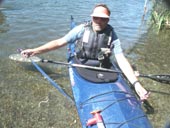 If you need extra long from your tether, then you would have
to unclip both ends and then slip one of the ends under your outside deck
line so you can get the most length of sling. In essence you are taking the
full length of deck sling out from under your deck lines and clipping one
end to your kayak and clipping the other end to the object you want tethered.
If you need extra long from your tether, then you would have
to unclip both ends and then slip one of the ends under your outside deck
line so you can get the most length of sling. In essence you are taking the
full length of deck sling out from under your deck lines and clipping one
end to your kayak and clipping the other end to the object you want tethered.
I know I will find more options as I play with the sling over
time.
If you do not have a cowtail on your PFD the deck sling is
a great alternative.
The deck sling, as you can see, has numerous possibilities.
It is one of those pieces of equipment that gives you an extra pair of hands
when in your cockpit. Since it is removable, it is also a great piece of equipment
to use around camp. You can use it to hang gear from trees or use it as a
mini clothes line. When hung over my neck I can clip some dry bags to the
sling to carry them from the kayak to camp and still have use of my hands.
The number of uses will be dependent on your creativity.
As you play with the deck sling and find interesting uses for the sling, please e-mail us those other uses (here at USK) and we will post them on the "USK Quicktips Page." I trust you will find the deck sling a useful tool to have when you need it.
Thank you Les and Diane for jogging my memory.
USK Home
Page
Pictures seen above are the property of USK. Any use of
this article and/or pictures is prohibited without written consent from
USK.
© Copyright USK
 In the first picture you can see the deck sling when it is
secured on the front deck. One of the many things I like about the sling is
it's low profile. I am using a flat webbing that used to be a tie down strap
with a buckle. When the buckle corroded I cut off the strap for other uses.
I tried it for the sling and it seems to be working well. I used two carabiners
that I had hanging around in my garage for testing purposes. When I get a
chance, I will use two stainless steel clips that don't have notches, which
can hook on lines when disconnecting. The clips are also smaller than the
carabiners seen here. See USK article, "Clipping
In For A Tow" for more details about the clips.
In the first picture you can see the deck sling when it is
secured on the front deck. One of the many things I like about the sling is
it's low profile. I am using a flat webbing that used to be a tie down strap
with a buckle. When the buckle corroded I cut off the strap for other uses.
I tried it for the sling and it seems to be working well. I used two carabiners
that I had hanging around in my garage for testing purposes. When I get a
chance, I will use two stainless steel clips that don't have notches, which
can hook on lines when disconnecting. The clips are also smaller than the
carabiners seen here. See USK article, "Clipping
In For A Tow" for more details about the clips. When the sling has both ends disconnected you can see how
it is placed under the deck rigging. It is important to have it sliding under
all deck lines. The outer most lines need to be static deck lines. If you
only have elastic deck lines then you lose certain functions that can only
be achieved with static (non-elastic) side deck lines.
When the sling has both ends disconnected you can see how
it is placed under the deck rigging. It is important to have it sliding under
all deck lines. The outer most lines need to be static deck lines. If you
only have elastic deck lines then you lose certain functions that can only
be achieved with static (non-elastic) side deck lines. To close the sling down to the deck, clip one side to the
outside deck line by crossing over the deck. This leaves you with one free
end. That free end is a convenient tether when you need it. Depending on which
side you need the tether, unclip the end you need.
To close the sling down to the deck, clip one side to the
outside deck line by crossing over the deck. This leaves you with one free
end. That free end is a convenient tether when you need it. Depending on which
side you need the tether, unclip the end you need. As for uses of this versatile tether, just think of all the
times you wish you had a quick way to attach something you didn't want to
drift or blow away. As you can see in one of the pictures, I have attached
the sling to hold my paddle. Since the clip is too small to clip over the
paddle shaft, I just wrapped the sling around the shaft and clipped the sling
to itself. Now I have hands free operation and my paddle stays close by.
As for uses of this versatile tether, just think of all the
times you wish you had a quick way to attach something you didn't want to
drift or blow away. As you can see in one of the pictures, I have attached
the sling to hold my paddle. Since the clip is too small to clip over the
paddle shaft, I just wrapped the sling around the shaft and clipped the sling
to itself. Now I have hands free operation and my paddle stays close by. In the USK article,
In the USK article,  As I mentioned earlier, the deck sling can slide from side
to side. This flexibility in length can be useful when towing a kayak where
the bow gets too close to your kidneys. When both ends are unclipped the sling
has equal length of tether on each side. However, when I pull on one side
to get more tether the other side gets shorter.
As I mentioned earlier, the deck sling can slide from side
to side. This flexibility in length can be useful when towing a kayak where
the bow gets too close to your kidneys. When both ends are unclipped the sling
has equal length of tether on each side. However, when I pull on one side
to get more tether the other side gets shorter.  If you need extra long from your tether, then you would have
to unclip both ends and then slip one of the ends under your outside deck
line so you can get the most length of sling. In essence you are taking the
full length of deck sling out from under your deck lines and clipping one
end to your kayak and clipping the other end to the object you want tethered.
If you need extra long from your tether, then you would have
to unclip both ends and then slip one of the ends under your outside deck
line so you can get the most length of sling. In essence you are taking the
full length of deck sling out from under your deck lines and clipping one
end to your kayak and clipping the other end to the object you want tethered.